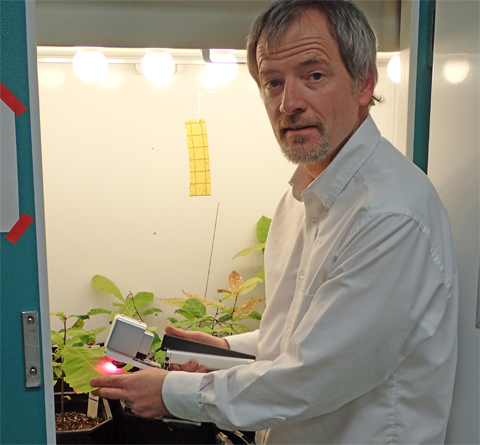
Dr. David Rosenthal measures photosynthetic parameters of American and hybrid chestnuts grown at temperature and CO2 levels predicted for later this century.
By Sydney Dawes
PACE Writer Environmental & Plant Biology
Dr. David Rosenthal, Assistant Professor of Environmental & Plant Biology, is putting an Ohio University Research Committee (OURC) award to work funding his student-interactive study of American Chestnuts.
The OURC is a competitive, internal university-wide award for research and scholarship. Rosenthal was awarded the funding in December 2015. He immediately began work, requesting seeds from the American Chestnut Foundation and planting them in February 2016. With the funding from the OURC, he was able to purchase carbon dioxide analyzers needed to control CO2 in the growth chambers.
“The purpose of this experiment is to try to understand how American Chestnuts would respond to climate change if it were to be reintroduced to Eastern forests,” Rosenthal said. His experiment extends the research of the American Chestnut Foundation. This foundation has successfully created a hybrid between the American Chestnut and the Chinese Chestnut that is resistant to the Chestnut blight, a plant pathogenic fungus that essentially eliminated the American Chestnut from eastern North American forests.
“The breeding program’s goal was to get trees that were resistant and looked like American Chestnut,” Rosenthal said. “The problem is that when they were doing all these selections, they weren’t really systematically also looking for physiological markers and adaptation of those genotypes.”
Globally, both mean temperature and atmospheric CO2 are increasing. Rosenthal’s experiment will assess if the new hybrids will act like American Chestnuts, not just look like them, by comparing different lineages with native chestnuts.
“The traits I’m interested in are related to carbon assimilation. The climate change stressors I’m interested in are increasing atmospheric carbon dioxide and temperature,” he said.
The spring class PBIO 3260 Plant Ecophysiology assisted with collecting data and informing the forest ecological community of their findings. According to Rosenthal, the data being collected “will allow us to model and predict chestnut growth and assimilation under climate change.”



















Comments